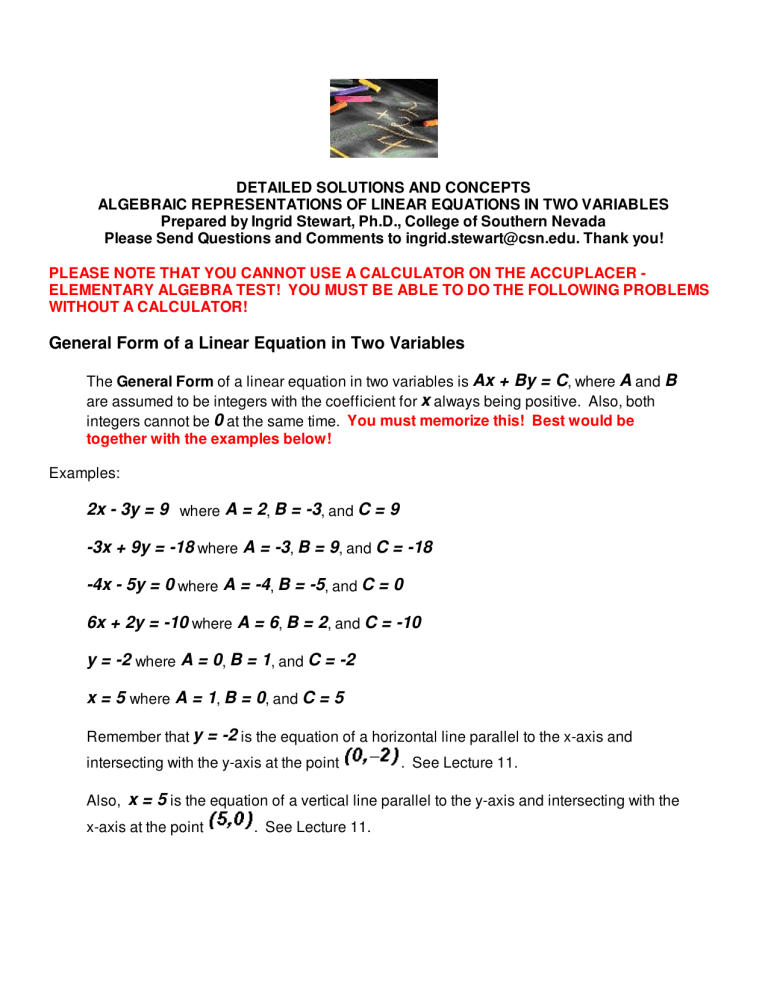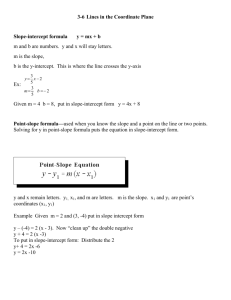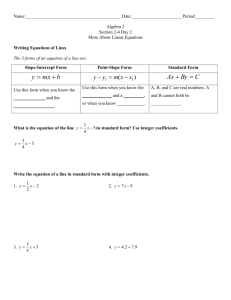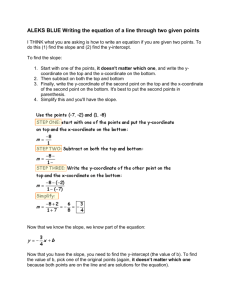Algebraic Representation of Linear Equations in Two Variables

DETAILED SOLUTIONS AND CONCEPTS
ALGEBRAIC REPRESENTATIONS OF LINEAR EQUATIONS IN TWO VARIABLES
Prepared by Ingrid Stewart, Ph.D., College of Southern Nevada
Please Send Questions and Comments to ingrid.stewart@csn.edu. Thank you!
PLEASE NOTE THAT YOU CANNOT USE A CALCULATOR ON THE ACCUPLACER -
ELEMENTARY ALGEBRA TEST! YOU MUST BE ABLE TO DO THE FOLLOWING PROBLEMS
WITHOUT A CALCULATOR!
General Form of a Linear Equation in Two Variables
The General Form of a linear equation in two variables is Ax + By = C , where A and B are assumed to be integers with the coefficient for x always being positive. Also, both integers cannot be 0 at the same time. together with the examples below!
You must memorize this! Best would be
Examples:
2x - 3y = 9 where A = 2 , B = -3 , and C = 9
-3x + 9y = -18 where A = -3 , B = 9 , and C = -18
-4x - 5y = 0 where A = -4 , B = -5 , and C = 0
6x + 2y = -10 where A = 6 , B = 2 , and C = -10 y = -2 where A = 0 , B = 1 , and C = -2 x = 5 where A = 1 , B = 0 , and C = 5
Remember that y = -2 is the equation of a horizontal line parallel to the x-axis and intersecting with the y-axis at the point . See Lecture 11.
Also, x = 5 is the equation of a vertical line parallel to the y-axis and intersecting with the x-axis at the point . See Lecture 11.
The Slope
We have already seen in Lecture 11 that the graphs of linear equations in two variables are lines of various steepness. This steepness is called SLOPE in mathematics. The slope is an integral part of a linear equation in two variables.
In layman's terms, the slope of a line is a measure of the steepness of the line. It is a ratio of the change in vertical distance over the change in horizontal distance as we "travel" from one point to another lying on the same line.
The slope m of a line through the distinct points and is calculated as follows
You must memorize this! Best would be together with the example below!
NOTE: Regardless of the sign of the x-coordinate or the y-coordinate, the minus between the y values and the x values in the slope calculation must always be there.
Example:
Find the slope of the graph of the linear equation containing the points (1, 2) and (3, 0)
.
We'll use the formula
Now it is up to us to decide which one of the given points is the set one is the set . and which
You will find that it does not matter. In either case, or
Slope and Horizontal Lines
The slope of all horizontal lines is m = 0
. You must memorize this!
Slope and Vertical Lines
Vertical lines do not have a slope. We say that their slope is undefined . You must memorize this!
Slope and Decreasing Lines
A line that rises from right to left has a negative slope . It is called a decreasing line.
You must memorize this!
Slope and Increasing Lines
A line that rises from left to right has a positive slope . It is called an increasing line. You must memorize this!
Slope-Intercept Form of a Linear Equation in Two Variables
Sometimes, it is to our advantage to know the slope-intercept form of a linear equation. It is simply a special way of rearranging the terms in the general form . All you have to do is isolate the y-variable on the left side.
The equation of the Slope Intercept Form of a linear equation is y = mx + b , where m is the slope of the line and b is the y-coordinate of the y-intercept. You must memorize this!
Problem 1:
Change the slope-intercept form of the linear equation to general form Ax
+ By = C so that the coefficient for x and y are integers with the coefficient for x a positive integer.
First, we'll bring the variables to the left side of the equal sign with x preceding y .
Lastly, we will multiply both sides by 3 to make the coefficient of x an integer to get 4x +
3y = 8 .
Problem 2:
Change the slope-intercept form of the linear equation to general form Ax +
By = C so that the coefficient for x and y are integers with the coefficient for x a positive integer.
First, we'll bring the variables to the left side of the equal sign with x preceding y .
Lastly, we will multiply both sides by -2 to make the coefficient of x a positive integer to get x - 2y = 7 .
Problem 3:
Find the slope and the coordinates of the y-intercept, if they exist, for the lines described as follows: a. y = -x + 3 slope: m = -1 coordinates of y-intercept: (0, 3) b. slope: m = coordinates of y-intercept: (0, -1) c. y = 2x slope: m = 2 coordinates of y-intercept: (0, 0) d. y = x slope: m = 1 coordinates of y-intercept: (0, 0) e. y = 1
This is a horizontal line!
slope: m = 0 coordinates of y-intercept: (0, 1) f. y + 9 = 0
This is the horizontal line y = -9 ! slope: m = 0 coordinates of y-intercept: (0, -9)
g. x = 1
This is a vertical line!
slope: undefined coordinates of y-intercept: NONE h. x + 24 = 0
This is the vertical line x = -24 !
slope: undefined coordinates of y-intercept: NONE
Problem 4:
Find the slope and the coordinates of the y-intercept for the line 3x - y = -1 .
Since we are given the general equation , we must first change it to the slopeintercept equation to find the requested information.
The Slope Intercept Form of a linear equation is y = mx + b . Note that in this form the y-variable is isolated on the left side of the equal sign and has a coefficient of positive
1 !
We need to accomplish this for 3x - y = -1 .
The first thing we will do is subtract 3x from both sides of the equation to get -y = -3x -
1 .
Note that the negative sign stays with the y-variable and immediately next to the equal sign.
-3x is placed
Since the y-variable must have a coefficient of positive 1 , we will multiply BOTH SIDES of the equation by -1 . Please note that we must work on BOTH SIDES of the equation! Please observe how this is being done!
-y(-1) = (-3x - 1)(-1) then we use the Distributive Property of Multiplication to get
-y(-1) = -3x(-1) - 1(-1) y = 3x + 1
Now we can find the slope and y-intercept easily!
That is, slope is m = 3 and the coordinates of y-intercept are (0, 1) .
Problem 5:
Change the linear equation 2x - 3y = 6 to slope-intercept form .
Note that in this form the y-variable is isolated on the left side of the equal sign and has a coefficient of positive 1 !
We need to accomplish this for 2x - 3y = 6 .
The first thing we will do is subtract 2x from both sides of the equation to get -3y = -2x +
6 .
Note that the negative sign stays with the y-variable and -2x is placed immediately next to the equal sign. The 6 is a positive integer that's why we now show + !
Since the y-variable must have a coefficient of positive 1 , we will multiply both sides of the equation by . then we use the Distributive Property of Multiplication to get and
Problem 6:
Change the linear equation to slope-intercept form
The first thing we will do is subtract 3x from both sides of the equation to get
.
Note the 5 is a positive integer that's why we now show + !
Since the y-variable must have a coefficient of positive 1 , we will multiply both sides of the equation by .
Finally, we use the Distributive Property of Multiplication to get and
Problem 7:
Change the linear equation -7.8x + 3.9y - 11.7 = 0 to slope-intercept form
.
The first thing we will do is add 7.8x
and 11.7
to both sides of the equation to get
3.9y = 7.8x + 11.7
Since the y-variable must have a coefficient of positive 1 , we will multiply both sides of the equation by . then we use the Distributive Property of Multiplication to get and
Problem 8:
Write the equation of the line with the given slope and y-intercept. For this we will use the slope-intercept form .
a. m = 2
, b = -5 y = 2x - 5 b.
m = -5
, b = 0 y = -5x c.
m = 3
, b = 1 y = 3x + 1
d.
m = 0
, b = -7 y = -7
Point-Slope Form of a Linear Equation in Two Variables
, where is a point on the line and the slope is m . You must memorize this!
NOTE: Regardless of the sign of the x-coordinate or the y-coordinate, the minus between the y values and the x values in the point-slope equation must always be there.
We will use the point-slope form to find the equation of a line, given at least two points on that line one point on the line and its slope
Problem 9:
Find the equation of a line passing through the points (1, 2) and (3, 0) . Solve the equation for y , if possible.
To accomplish this, we'll use the Point-Slope Form of the linear equation and to find the slope m , we'll use the formula
First, it is up to us to decide which one of the given points is the set one is the set .
In either case, or and which
Then, we'll use the point-slope form of the linear equation to find y - 2 = -1(x - 1) or y - 0 = -1(x - 3) depending on which coordinates you use.
Lastly, we solve either equation for y on the left in either equation to get y = -x + 3 .
Problem 10:
Find the equation of a line passing through the points (1, 2) and (1, -5) . Solve the equation for y , if possible.
To accomplish this, we'll use the point-slope form of the linear equation and to find the slope m , we'll use the formula
First, it is up to us to decide which one of the given points is the set one is the set . and which
Let's use
Please note that we cannot use the point-slope form because the slope is undefined, that is, we could not find a value. However, we do know that the only lines that have undefined slopes are vertical lines.
We also know that their equations are the line.
x = a , where a is the x-coordinate of any points on
Knowing that both given points have an x-coordinate of 1 , the equation of the line must be x = 1 .
Problem 11:
Find the equation of a line passing through the points (2, 1) and (-5, 1) . Solve the equation for y , if possible.
To accomplish this, we'll use the point-slope form of the linear equation and to find the slope m , we'll use the formula
First, it is up to us to decide which one of the given points is the set one is the set . and which
Let's use
In this case, we could use the the point-slope form because the slope is 0 and this is a perfectly good value. However, we do know that the only lines that have undefined slopes are vertical lines. y - 1 = 0(x - 2) then y -1 = 0 and y = 1
However, the only lines that have slopes m = 0 are horizontal lines. We know that their equations are y = b , where b is the y-coordinate of any points on the line.
Knowing that both given points have a y-coordinate of 1 , the equation of the line must be y = 1 .
Problem 12:
Find the equation of a line given the point equation in general form .
and the slope . Express the
Lastly, we'll bring the variables to the left side of the equal sign with x preceding y .
and multiplying the equation by of the line.
3 , we get
Problem 13:
, which is the general equation
Write an equation of a vertical line through the point (-2, 6) .
We know that a vertical line has an equation of x = a , where a is any value. That is, the a is the x-value of any point on the vertical line.
Since we have one point on the vertical line given whose x-value is -2 , the equation of the vertical line through the point (-2, 6) must be x = -2 .
Problem 14:
Write an equation of a line with undefined slope through the point (3, -5) .
We know that only vertical lines have undefined slope . Again, the equation of a vertical line is x = a the vertical line.
, where a is any value. That is, the a is the x-value of any point on
Since we have one point on the vertical line given whose x-value is 3 , the equation of the vertical line through the point (3, -5) must be x = 3 .
Problem 15:
Write an equation of a horizontal line through the point (-2, 6) .
We know that a horizontal line has an equation of y = b , where b is any value. That is, the b is the y-value of any point on the horizontal line.
Since we have one point on the horizontal line given whose y-value is 6 , the equation of the horizontal line through the point (-2, 6) must be y = 6 .
Problem 16:
Find the general equation of the following line.
We note that the intercepts of this line have the coordinates allows us to find the equation as follows.
(-2, 0) and (0, -4) . This
First, we find the slope m given its formula .
Next, we'll use the point-slope form of the linear equation y - 0 = -2[x - (-2)] then y = -2(x + 2) and y = -2x - 4
and how about the point (-2, 0)
?
Since we are asked to find the general equation we change the equation above as follows:
2x + y = - 4
Problem 17:
Find the slope-intercept equation of the following line.
We note that this line has one intercept at the origin allows us to find the equation as follows.
(0, 0) and a point at (1, 3) . This
First, we find the slope m given its formula
Next, we'll use the point-slope form of the linear equation
and how about the point (0, 0)
?
y - 0 = 3(x - 0) then y = 3x
.
Problem 18:
Find the equation of the following line.
We note that this line has one intercept at find the equation as follows.
(0, 1) and a point at (2, 1) . This allows us to
First, we find the slope m given its formula .
Next, we'll use the point-slope form of the linear equation y - 1 = 0(x - 0) then y -1 = 0
and how about the point (0, 1)
?
Since we are asked to find the slope-intercept equation we change the equation above as follows: y = 1
Slope and Parallel Lines
Two lines are parallel if they have the same slope.
Slope and Perpendicular Lines
The slopes of perpendicular lines are negative reciprocals.
NOTE: Perpendicular lines intersect in a 90º angle.
Problem 19:
Are the lines y = -x + 3 and y = 5 - x parallel? Answer Yes or No!
Since y = 5 - x can be written as y = - x + 5 , we can see that both equations have the same slope m = -1 .
Problem 20:
Are the lines y = -x + 3 and y - x = 2 parallel? Answer Yes or No!
You really cannot compare yet, because the second line is not represented by a Slope-
Intercept Equation . Therefore, let's change it as follows y - x = 2 y = x + 2 , which indicates that m = 1 .
Since the slope of y = -x + 3 is m = -1 the two lines are NOT parallel.
Problem 21:
Are the lines and perpendicular? Answer Yes or No!
Yes, because the slope of the first equation is , which is the negative reciprocal of , the slope of the second equation.
Problem 22:
What is the slope of a line perpendicular to the line y = 2x - 5 ?
Since of 2
, the slope of a line perpendicular to the given line is the negative reciprocal
. Therefore, .
Problem 23:
Write the Slope-Intercept Equation of a line through point (2, 5) . The new line is to be parallel to the line 9x - 3y = -6 .
Let's find the slope of the line 9x - 3y = -6 by changing its equation
- 3y = -9x - 6 y = 3x + 2
We can see that the slope of the line is m = 3 .
Since the new line is to be parallel to 9x - 3y = -6 , it also has m = 3 . However, the new line is to go through the point (2, 5) .
Given the slope of a line and one point on the line, we can now use the Point-Slope
Equation to find the equation of the requested line.
y - 5 = 3 (x - 2) y - 5 = 3x - 6 and since we were asked to find the Slope-Intercept Equation , let's isolate the y-variable as follows y = 3x - 6 + 5 y = 3x - 1
Problem 24:
Find the Slope-Intercept Equation of a line through point (-1, 3) . The new line is to be perpendicular to the line x - 3y = 12 .
Let's find the slope of x - 3y = 12 by changing its equation
- 3y = - x + 12 y = x - 4
We can see that the slope of the line is m = .
Since the new line is to be perpendicular to the given line, its slope is the negative reciprocal of which is . Therefore, the new line has slope m = -3 . However, the new line is to go through the point (-1, 3) .
Given the slope of a line and one point on the line, we can now use the Point-Slope
Equation to find the equation of the requested line.
y - 3 = - 3 [x - (-1)] y - 3 = - 3 (x + 1) y - 3 = -3x - 3 and since we were asked to find the Slope-Intercept Equation , let's isolate the y-variable as follows y = -3x - 3 + 3 y = - 3x





